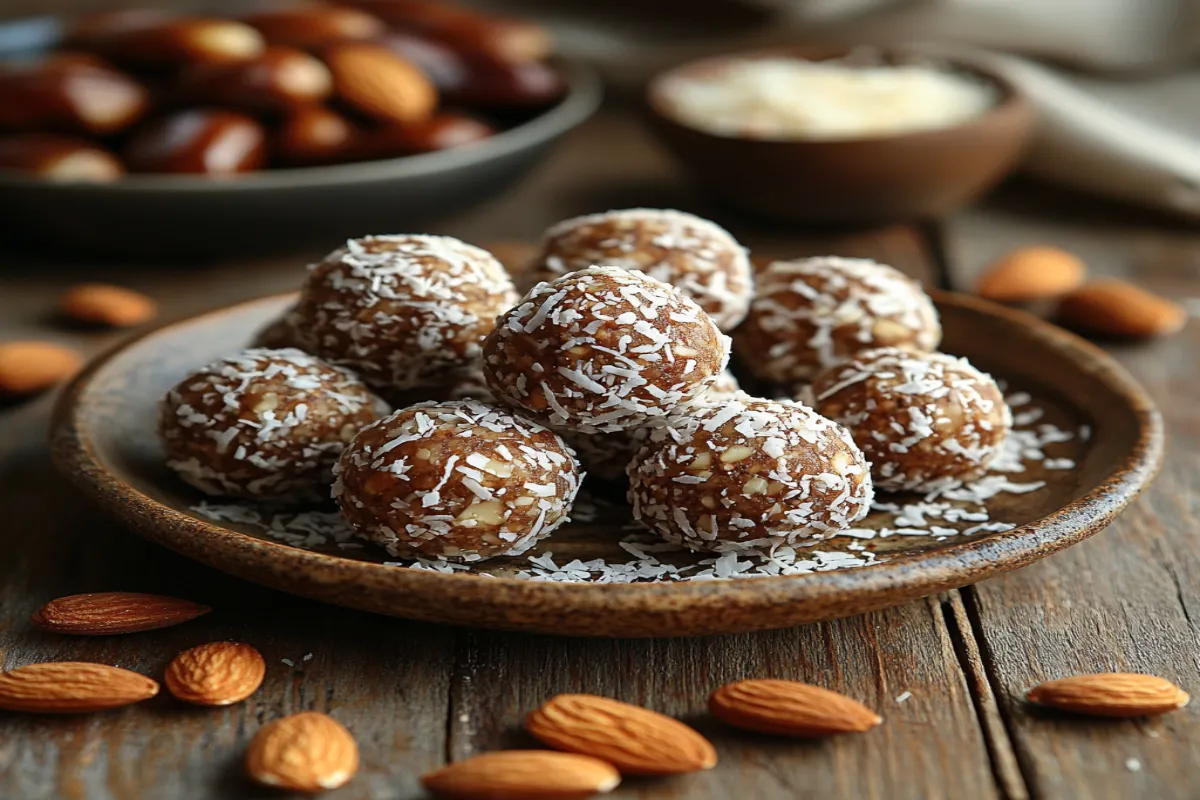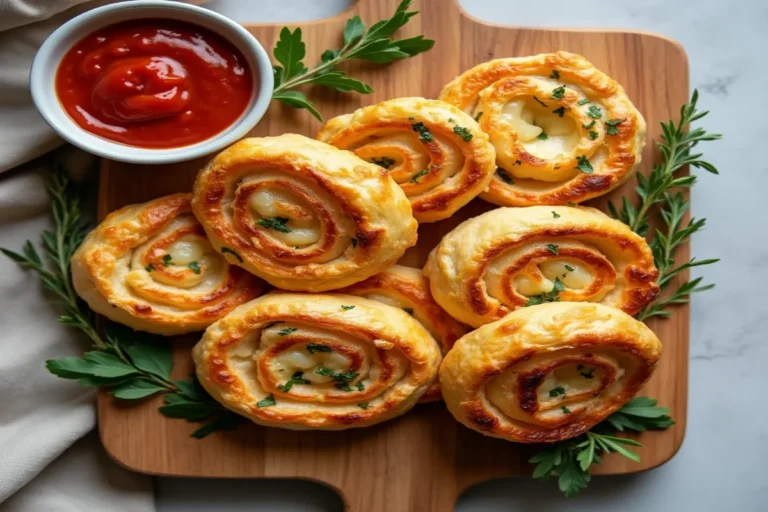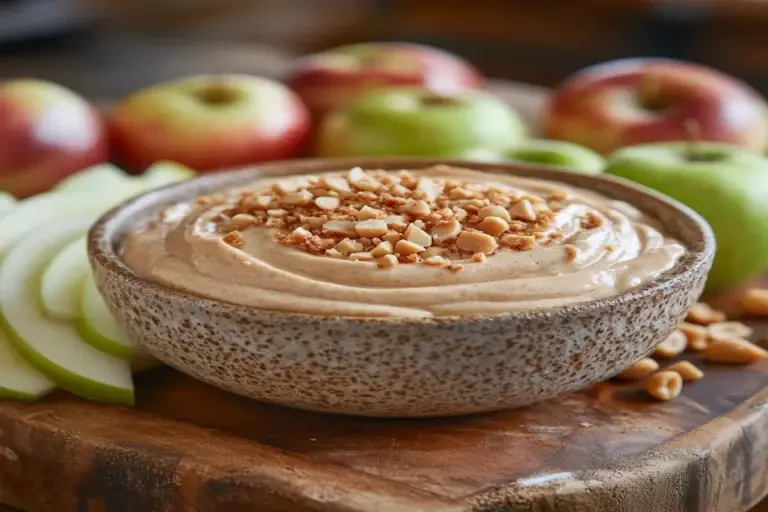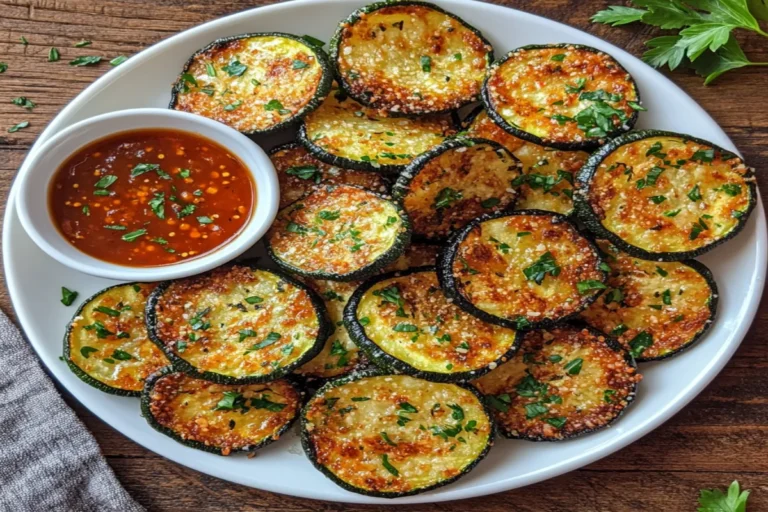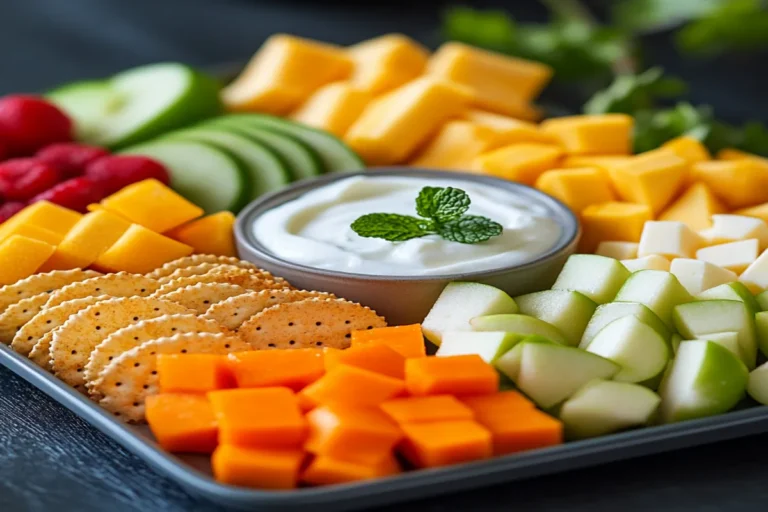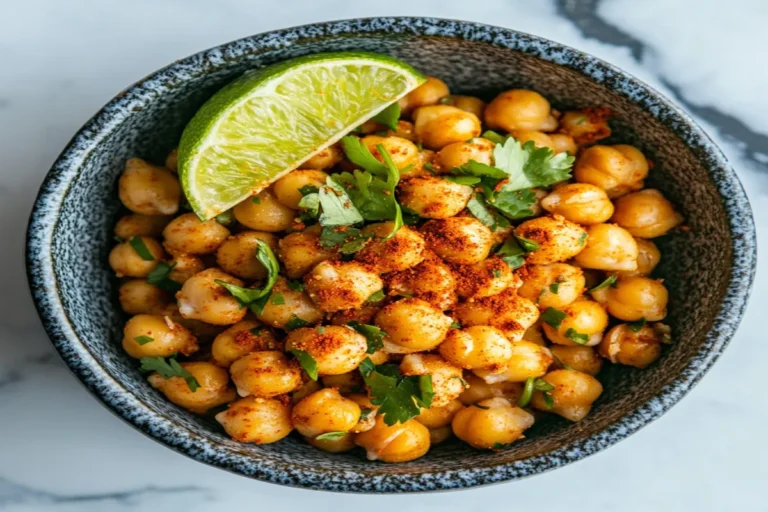Date and Nut Energy Balls with Coconut – Easy Snack Recipe
In our fast-paced world where quick snacks often mean processed foods loaded with artificial ingredients, energy balls emerge as a refreshing solution that marries convenience with wholesome nutrition. These bite-sized powerhouses deliver sustained energy without the crash that accompanies sugary alternatives, making them the ideal companion for busy lifestyles, active pursuits, or simply satisfying afternoon cravings.
My relationship with energy balls began during marathon training, when I desperately needed portable fuel that wouldn’t weigh me down or cause digestive distress during long runs. After experimenting with countless store-bought options that either tasted like cardboard or contained ingredient lists resembling chemistry textbooks, I discovered the magic of making my own. The first batch—simple combinations of dates, almonds, and coconut—became an instant revelation. Here was everything I needed: natural sweetness, satisfying protein, healthy fats, and a texture that felt like indulgence rather than obligation.
The beauty of date and nut energy balls lies in their brilliant simplicity. Medjool dates provide natural sweetness and act as a binding agent, while nuts contribute protein, healthy fats, and satisfying crunch. Shredded coconut adds tropical flavor and helps create the perfect texture that holds together beautifully. Together, these three ingredients create a synergy that tastes like dessert while functioning as serious nutrition—the perfect example of food that loves you back.
Table of Contents
The Rise of Energy Balls in Healthy Snacking
Energy balls have carved out their own category in the healthy snacking revolution, representing a shift away from processed convenience foods toward whole food alternatives that actually nourish rather than merely fill. This isn’t just another health food trend—it’s a return to the fundamental principle that the best fuel for our bodies comes directly from nature.
The nutritional foundation of energy balls rests primarily on dates, which deserve recognition as one of nature’s most perfect foods. These wrinkled fruits pack an impressive array of nutrients including potassium, copper, and manganese, while providing natural sugars that deliver quick energy without the blood sugar rollercoaster associated with refined sweeteners. The fiber content in dates—approximately 6.7 grams per 100 grams—helps slow sugar absorption, creating sustained energy release rather than the spike-and-crash cycle of processed snacks.
Beyond nutrition, energy balls excel in pure convenience. Unlike granola bars that crumble in backpacks or fresh fruit that bruises easily, energy balls maintain their structure while traveling, require no refrigeration for short periods, and can be eaten one-handed while commuting, hiking, or chasing children through playgrounds. This portability factor has made them favorites among busy professionals, athletes, parents, and students—anyone who needs reliable energy on demand.
The popularity of energy balls also reflects broader dietary trends toward plant-based eating, minimal processing, and ingredient transparency. In an era where consumers increasingly scrutinize food labels, energy balls offer the ultimate transparency—you literally see every ingredient going into them. This no-bake approach preserves the nutritional integrity of ingredients while making the preparation accessible to anyone with a food processor, regardless of baking skills or kitchen equipment.
The customization possibilities are virtually endless, allowing individuals to tailor their energy balls to specific dietary needs, flavor preferences, or nutritional goals. Whether someone needs gluten-free options, wants to boost protein content, or simply prefers chocolate over vanilla, energy balls accommodate these preferences while maintaining their fundamental wholesome character.
Ingredient Spotlight Of Energy Balls
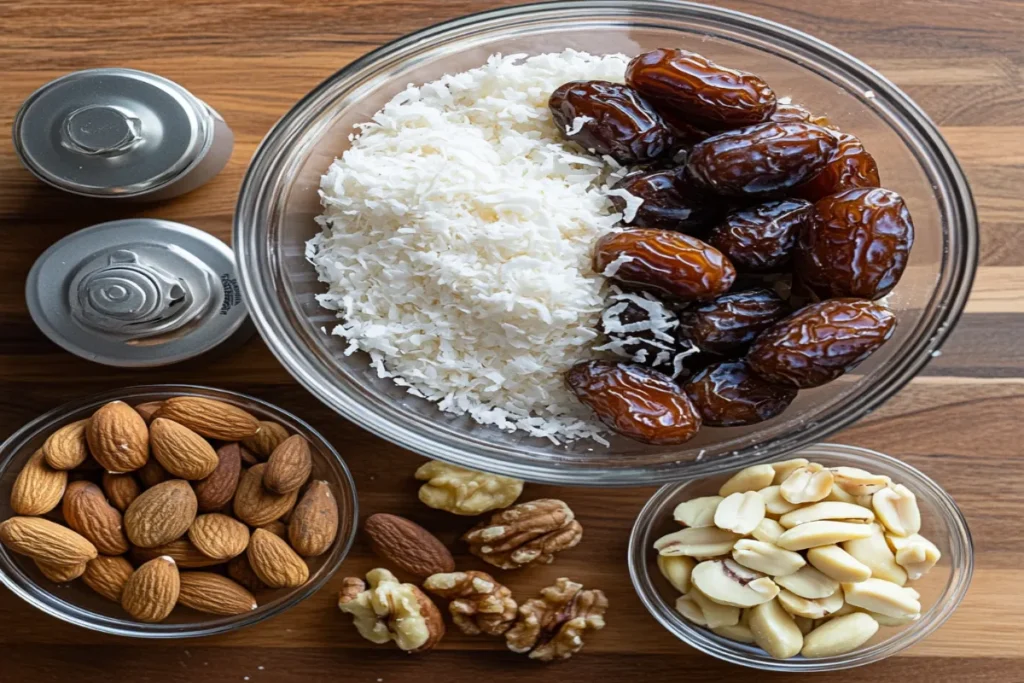
The magic of exceptional energy balls begins with understanding each component’s unique contribution to flavor, texture, and nutrition. Quality ingredients make the difference between energy balls that taste like obligation and those that feel like treats.
Dates form the foundation of most energy ball recipes, acting as both primary sweetener and binding agent. Medjool dates reign supreme for energy balls due to their large size, soft texture, and rich, almost caramel-like sweetness that requires no additional sweeteners. These “king of dates” blend smoothly and provide enough natural stickiness to hold other ingredients together. Deglet Noor dates work well too, though their firmer texture may require soaking in warm water for 10-15 minutes before processing. Fresh dates work better than dried ones, which can be too firm and may not provide adequate binding. When selecting dates, look for plump, glossy specimens without crystallized sugar on the surface, which indicates aging.
Nuts provide protein, healthy fats, and textural contrast that transforms energy balls from simple fruit treats into satisfying snacks capable of sustaining energy for hours. Almonds offer mild flavor and substantial protein (approximately 6 grams per ounce), making them the most versatile choice for beginners. Walnuts contribute omega-3 fatty acids and a slightly bitter note that balances the dates’ sweetness beautifully. Cashews create incredibly creamy texture when processed, while pecans add buttery richness. For those seeking maximum nutrition, consider raw nuts over roasted ones, as they retain more nutrients and blend more smoothly.
Coconut serves multiple roles beyond its tropical flavor contribution. Unsweetened shredded coconut adds texture, helps absorb excess moisture from dates, and provides healthy saturated fats that enhance satiety. The fiber in coconut (approximately 4 grams per ounce) contributes to the sustained energy release these snacks provide. Choose unsweetened varieties to control sweetness levels and avoid unnecessary additives. Fine shred coconut distributes more evenly throughout the mixture, while larger flakes provide more noticeable texture—both work depending on your preference.
Optional Add-ins expand possibilities exponentially while addressing specific nutritional or flavor goals. Chia seeds contribute omega-3 fatty acids, fiber, and a slight crunch while remaining virtually flavorless. Raw cacao powder transforms basic energy balls into chocolate indulgences while providing antioxidants and magnesium. Protein powder boosts the protein content significantly, making these ideal post-workout snacks—vanilla and chocolate flavors work particularly well. Vanilla extract enhances sweetness perception without adding calories, while cinnamon provides warmth and may help with blood sugar regulation.
Selecting the Right Ingredients
Creating exceptional energy balls requires attention to ingredient quality and thoughtful customization based on dietary needs and flavor preferences. The difference between mediocre and memorable energy balls often comes down to these seemingly small details.
Quality matters significantly in energy balls because there’s nowhere to hide inferior ingredients. Since these snacks contain minimal components with no cooking to transform or mask flavors, each ingredient must contribute positively to the final result. Choose dates that feel soft and pliable—hard, dried-out dates will never achieve the smooth consistency needed for proper binding. When possible, buy nuts from stores with high turnover to ensure freshness, as rancid nuts will ruin an entire batch of energy balls.
Store nuts properly to maintain quality. Raw nuts should be refrigerated or frozen to prevent rancidity, especially during warm months. Taste nuts before using them—they should have clean, sweet flavors without any bitter or off notes. If nuts seem stale, toasting them lightly in a dry skillet for 2-3 minutes can refresh their flavor, though allow them to cool completely before processing.
Customization allows these energy balls to accommodate virtually any dietary restriction or preference. For nut-free versions, sunflower seeds provide similar texture and nutrition, though the flavor will be distinctly different. Pumpkin seeds (pepitas) work well too, offering magnesium and zinc. Those following grain-free diets can add rolled oats (ensure they’re certified gluten-free if celiac disease is a concern) for heartier texture and additional fiber.
For enhanced protein content, particularly valuable for post-workout snacks, incorporate 1-2 scoops of high-quality protein powder. Vanilla and unflavored options blend most seamlessly, while chocolate protein powder creates rich chocolate energy balls when combined with cacao powder. Keep in mind that protein powder absorbs moisture, so you may need additional dates or a splash of liquid to maintain proper consistency.
Flavor pairings offer endless creative possibilities. Classic combinations include almond-coconut-vanilla, walnut-cinnamon-date, and cashew-cocoa-coconut. More adventurous pairings might include pistachio-rose water-coconut, pecan-maple extract-coconut, or macadamia-lime zest-coconut. Consider seasonal additions like pumpkin pie spice during fall or dried cranberries and orange zest during winter holidays.
For those managing blood sugar, adding ingredients with healthy fats and protein helps slow sugar absorption. Hemp hearts, ground flaxseed, or additional nuts serve this purpose while contributing their own nutritional benefits. Conversely, those needing quick energy (like athletes) might prefer formulations higher in dates relative to other ingredients.
Step-by-Step Preparation Guide For Energy Balls
Creating perfect energy balls requires minimal time investment—approximately 15 minutes of active preparation—but attention to technique ensures consistent, professional-quality results every time.
Begin by gathering your ingredients: 1½ cups pitted Medjool dates (about 12-15 dates), 1 cup raw nuts of choice, ½ cup unsweetened shredded coconut, ¼ teaspoon vanilla extract, and a pinch of salt. If your dates seem particularly dry or firm, soak them in warm water for 10-15 minutes, then drain thoroughly and pat dry with paper towels.
Equipment preparation makes the process smoother. Fit your food processor with the standard S-blade and ensure the bowl is completely clean and dry—any moisture will interfere with proper processing. Have a small bowl of water nearby for moistening your hands when forming balls, and prepare a parchment-lined plate or container for the finished energy balls.
Processing technique determines the final texture and binding capability. Add the pitted dates to the food processor first, processing until they form a paste-like consistency, approximately 1-2 minutes. This step is crucial—inadequately processed dates won’t bind the mixture properly. The dates should clump together when squeezed and show no visible chunks.
Add the nuts to the date paste and pulse 8-10 times before processing continuously for 30-45 seconds. The goal is to break down the nuts enough that they incorporate with the dates while maintaining some texture—completely smooth nut butter won’t provide the textural interest that makes energy balls satisfying. You should see small nut pieces throughout the mixture.
Add the coconut, vanilla extract, and salt, then pulse just enough to distribute these ingredients evenly—typically 5-6 pulses. Over-processing at this stage can make the coconut too fine and affect the final texture.
Test the mixture’s consistency by pinching a small amount between your fingers. It should hold together easily without being overly sticky or dry. If too dry (mixture doesn’t hold together), add one or two additional dates and process briefly. If too wet (mixture sticks excessively to hands), add a tablespoon of coconut or ground nuts.
Forming uniform balls requires slightly damp hands to prevent sticking. Using a small cookie scoop or tablespoon, portion the mixture into equal amounts—this recipe typically yields 18-20 balls. Roll each portion between your palms using gentle pressure to create smooth, round balls. Don’t apply too much pressure, which can make the balls dense and hard.
Arrange the finished energy balls on a parchment-lined plate or in an airtight container. For the best texture and flavor, refrigerate for at least 30 minutes before serving, which allows the flavors to meld and the texture to firm up slightly.
Store energy balls in an airtight container in the refrigerator for up to two weeks. For longer storage, freeze them in a single layer on a parchment-lined tray until solid, then transfer to freezer bags or containers. Frozen energy balls keep for up to three months and can be thawed at room temperature for 15-20 minutes before eating.
Tips for Perfect Energy Balls
Achieving energy ball perfection involves understanding the interplay between ingredients and mastering a few key techniques that separate good energy balls from exceptional ones.
Consistency is paramount to energy ball success, and achieving the right texture requires balancing moisture content with binding capability. The mixture should hold together when squeezed but not be so wet that it sticks excessively to your hands or so dry that it crumbles when formed. Date moisture content varies significantly based on variety, age, and storage conditions, so be prepared to adjust accordingly. If the mixture seems too sticky, add more coconut or finely ground nuts a tablespoon at a time. If too dry, add one or two additional dates rather than liquid, which can make the mixture too wet.
Temperature affects the mixture’s workability significantly. If your kitchen is particularly warm, the mixture may become too soft to handle easily. Refrigerate the mixture for 15-20 minutes before forming balls, which makes handling much easier. Conversely, if the mixture seems too firm (perhaps because ingredients were cold), allow it to sit at room temperature for 10-15 minutes before proceeding.
Flavor enhancement often comes from small additions that create big impacts. A tiny pinch of high-quality sea salt enhances all other flavors without making the energy balls taste salty. Vanilla extract should be pure rather than imitation for the best flavor contribution. For chocolate variations, use raw cacao powder rather than cocoa powder for superior flavor and nutrition. Toast spices like cinnamon briefly in a dry pan before adding to intensify their flavor.
Size consistency ensures even eating experiences and professional appearance. Use a small cookie scoop or measuring spoon to portion the mixture, aiming for pieces about the size of a walnut in the shell. Roll them between your palms with gentle, consistent pressure—too much pressure creates dense, hard balls, while too little leaves them lumpy or loose.
Common mistakes can derail even well-intentioned energy balls. Over-processing creates nut butter rather than textured energy balls, so process in stages and check consistency frequently. Under-processing leaves chunks too large to bind properly, resulting in crumbly balls that fall apart. Skipping the resting period in the refrigerator means missing the flavor melding and texture firming that transforms good energy balls into great ones.
Avoid using dates that are too old or dry, which will never achieve proper binding regardless of processing time. Similarly, rancid nuts will ruin the entire batch—always taste nuts before using them. Don’t substitute different types of coconut without adjusting other ingredients; sweetened coconut adds sugar and moisture that changes the balance, while coconut flour absorbs moisture differently than shredded coconut.
Variations to Explore
The basic date-nut-coconut formula serves as a foundation for countless creative variations that can transform these energy balls into exciting new treats while maintaining their wholesome character.
Chocolate Coconut Energy Balls satisfy chocolate cravings while maintaining nutritional integrity. Replace ¼ cup of the coconut with raw cacao powder, and consider adding a handful of mini dark chocolate chips (dairy-free if needed) for textural surprise. The cacao provides antioxidants and magnesium while creating rich chocolate flavor that pairs beautifully with coconut. For extra indulgence, roll the finished balls in additional cacao powder mixed with coconut.
Nut-Free Alternatives accommodate allergies without sacrificing satisfaction. Replace nuts with an equal amount of sunflower seeds, pumpkin seeds, or a combination of both. These seeds provide different mineral profiles—sunflower seeds are rich in vitamin E and magnesium, while pumpkin seeds provide zinc and iron. The flavor will be distinctly different but equally satisfying. For those who can tolerate tree nuts but not peanuts, any tree nut works beautifully in the basic formula.
Protein-Packed Variations turn energy balls into serious post-workout fuel. Add 1-2 scoops of high-quality protein powder, adjusting the date quantity as needed to maintain proper consistency. Vanilla protein powder works with virtually any flavor combination, while chocolate protein powder pairs perfectly with cacao or coconut. Plant-based protein powders work just as well as whey-based options, though they may require slight adjustments to liquid content.
Seasonal Flavor Profiles keep energy balls exciting throughout the year. Fall-inspired versions might include pumpkin pie spice (cinnamon, nutmeg, ginger, cloves) with pecans and a touch of maple extract. Winter variations could feature gingerbread spicing (ginger, cinnamon, cloves, allspice) with crystallized ginger pieces for textural interest. Spring might inspire lemon zest and poppy seed combinations, while summer could highlight lime zest with macadamia nuts.
Superfood Boost Versions amplify nutritional content with trending superfoods. Add chia seeds for omega-3 fatty acids and fiber, goji berries for antioxidants and chewy texture, or hemp hearts for complete protein and healthy fats. Maca powder contributes earthy, slightly caramel-like flavor while providing adaptogenic benefits. Spirulina creates vibrant green color and adds protein, though use sparingly as the flavor can be strong.
Tropical Paradise Balls emphasize the coconut element with complementary tropical flavors. Add dried pineapple pieces, lime zest, and macadamia nuts for a vacation-inspired treat. A tiny amount of coconut extract intensifies the tropical flavor, while freeze-dried mango or passion fruit powder creates exotic taste profiles.
Caffeine-Enhanced Versions provide gentle energy boosts for those who need them. Add a small amount of instant coffee or espresso powder for mocha-inspired energy balls, or try matcha powder for sustained energy with antioxidant benefits. These additions should be subtle—too much creates bitter flavors that overpower the natural sweetness.
Frequently Asked Questions
Can I use different types of dates for this recipe?
While Medjool dates work best due to their soft texture and rich sweetness, other varieties can be substituted with some adjustments. Deglet Noor dates are firmer and less sweet, so they may require soaking in warm water for 10-15 minutes before processing, and you might need an extra date or two to achieve proper binding and sweetness. Zahidi dates work well but tend to be less sweet than Medjools. Halawi dates are very soft and sweet, making them excellent alternatives, though they can make the mixture quite sticky. Avoid dates that are too old or crystallized, as they won’t process smoothly regardless of variety. Fresh, pliable dates are always preferable to dry, hard ones.
How long do energy balls last, and what’s the best storage method?
Properly stored energy balls maintain quality for up to two weeks in the refrigerator. Place them in an airtight container with parchment paper between layers if stacking to prevent sticking. The cool temperature helps maintain their shape and prevents the dates from becoming too soft. For room temperature storage, they’ll keep for 3-4 days in cool weather, but may become too soft in warm conditions. The natural oils in nuts can become rancid over time, so refrigeration is always recommended for optimal freshness and safety. Always check for any off odors or flavors before eating energy balls that have been stored for extended periods.
Can energy balls be frozen for longer storage?
Energy balls freeze exceptionally well and can be stored for up to three months in the freezer. Freeze them individually on a parchment-lined tray until solid (about 2 hours), then transfer to freezer bags or airtight containers. This prevents them from sticking together and allows you to remove individual portions as needed. Frozen energy balls can be eaten directly from the freezer for a firmer texture, or thawed at room temperature for 15-20 minutes to return to their normal consistency. They also thaw quickly in lunch boxes, making them perfect for school or work snacks that will be ready to eat by lunch time.
Are these energy balls appropriate for children, and can I modify them for kids?
Energy balls make excellent healthy snacks for children, providing natural energy without artificial additives or excessive sugar. The natural sweetness from dates appeals to most children while delivering fiber, potassium, and other nutrients. For very young children, ensure nuts are processed finely enough to avoid choking hazards, or consider nut-free versions using seeds. Some modifications that appeal to children include rolling the balls in additional coconut for a “snowball” effect, adding mini chocolate chips for extra appeal, or creating fun shapes instead of balls. The portion size is naturally appropriate for small hands and appetites, and the lack of artificial colors and flavors makes them suitable for children with sensitivities.
Conclusion
Date and nut energy balls with coconut represent the perfect convergence of convenience, nutrition, and satisfaction—proving that healthy snacking doesn’t require compromise on flavor or enjoyment. These little powerhouses deliver sustained energy through whole food ingredients that actually nourish your body while satisfying cravings for something sweet and substantial.
The beauty of this recipe lies not just in its nutritional benefits, but in its remarkable adaptability. Whether you’re fueling morning workouts, packing school lunches, or simply seeking a guilt-free afternoon treat, these energy balls rise to meet the occasion. The endless variation possibilities mean you’ll never get bored, and the simple preparation makes them accessible even to kitchen novices.
More than just a snack, energy balls represent a mindful approach to eating—choosing foods that provide genuine nourishment rather than empty calories. In a world full of processed convenience foods, taking ten minutes to create something wholesome from recognizable ingredients feels like both self-care and rebellion against the industrial food system.
We’d love to hear about your energy ball adventures! Have you tried any of the variations suggested, or created your own unique combinations? What’s your favorite mix of nuts and add-ins? Share your experiences and discoveries in the comments below—your creativity might inspire the next great flavor combination that becomes someone else’s new favorite snack.
For more wholesome recipes that prove healthy eating is delicious eating, subscribe to our newsletter. Each week, we share new ideas for nourishing your body without sacrificing flavor or satisfaction. From energy-boosting breakfasts to satisfying dinners and everything in between, we’re here to support your journey toward more mindful, joyful eating.
What’s your next energy ball creation going to be?

